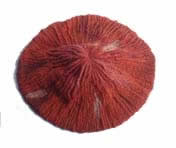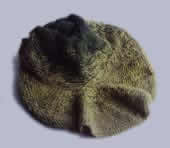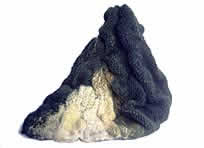Keiko Hasegawa
The 2001 Knitting & Stitching Show:
exhibited work



Up until then, my standard of knitting was poor. I had once had the opportunity to learn how to use a knitting machine, so I could manage to make basic knitwear for my children . My hand knitting skills, however, were rather limited and I was largely self-taught from knitting pattern books. As I had previously experienced many times through my profession how exciting and rewarding it could be to see finished products after several months of development, I could easily imagine the means of taking of my knitting skills to a higher standard. I joined a local knitting class, quite casually, even taking my children with me. It was the real start of my 'knitting life'. It was supposed to be my small pleasure, but it produced many mixed feelings - not just 'How interesting knitting is', but 'What hard work!'
When my knitting skills improved, I made a piece entitled 'Wild Flowers' inspired by a book written by Edith Holden called 'The Country Diary of an Edwardian Lady'. Unfortunately, the comments from my classmates about this piece were all negative, and I started to loose confidence in my knitting. During this period, I attended the 'Fushiginoiroito Workshop' for the first time, where reactions to this piece were very different and much more positive. I was so encouraged that I assured myself I would carry on making whatever I felt was right and in touch with my instincts.
My next important turning point was through my piece entitled 'Red Mt.Fuji'.
I saw an exhibition of traditional Japanese Kimono costumes by the master craftsman, Ithiku Kubota. He successfully transformed a piece of cloth into something so completely different, using tie-dye techniques and embroideries. He created such powerful forces, rich textures, and unique relief-patterned surfaces. His pieces appealed to me enormously. Up until to this point I only saw knitting as being little more than a combination of various stitches within a flat surface. This experience opened my eyes wider, and made me want to push myself much further, however simple the methods and techniques I used were.
Influenced by Ithiku Kubota's work, I started my piece -' Red Mt.Fuji'. My intention was to transfer a picture of 'Red Mt.Fuji' onto the surface of a waistcoat. I had already knitted half way into the second part of the garment, making both parts with exactly the same pattern, in my usual manner of knitting, when suddenly my hands froze. There was something very wrong and it was far from what I wanted to make! My intension was to express one aspect of my impression of Mt.Fuji and not its overall view. I was so dissatisfied that I left it at this point, just as it was. The work, however, was useful in that it led me to discover various new possibilities that I could achieve through introducing tucking and folding methods into my knitting. I call this the 'Pin Tuck' method.
I decided to begin this piece again using the 'Pin Tuck' method. I mixed bigger tucks and smaller ones together, which reminded me of the valleys and hills on the surface of a mountain. I created my piece -'The Light at Dawn' using this technique. This was my Mt.Fuji, burning red and wrapped with morning sunlight. Another challenge I faced through this piece was 'mixing' colours. I couldn't find any yarns in the exact red I was searching for, so, for the first time, I dyed my own yarn. I soon realized, however, that there could be no magic paint box without skilled hands. I was left, following this, with various closely hued red yarns. I experimented to combine these closely matched yarns together and knit as one thread, and the result was very interesting.
Although at close quarters the colours of the yarns didn't blend well together and rough patches of each colour stood out, from a distance the effect was different. The result was a deeper and more delicate impression of colour which enhanced the overall appearance. Even colours hidden underneath other yarns seemed to exert some influence, shouting out their existence.
My ambition was to create, using these techniques, a 'mountain view' seen at three different times of day - dawn, daylight, and sunset. To date I have found 'daylight' the most difficult to capture because it seems to have a transparent quality. My first attempts to create transparency effects using my original yarns were a failure. I changed direction, using different materials that had inherent transparent qualities, such as nylon thread, vinyl tape and cling film. I twisted coloured yarns with transparent materials and knitted with this. My experiments from here will continue further along this road in the search for new possibilities.
My only wish is to create once more the familiar surfaces of the mountain that I used see everyday at my home town.